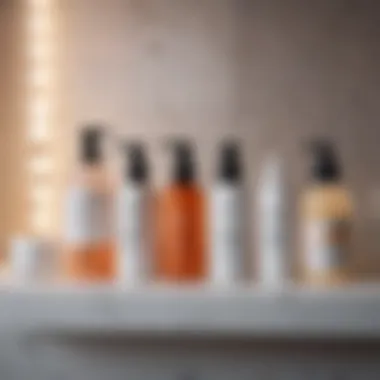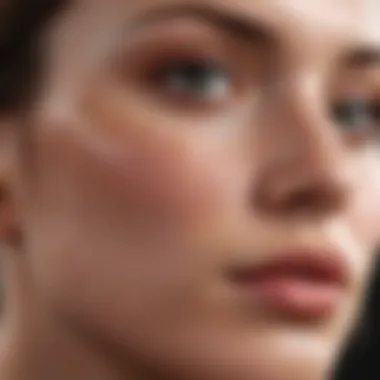Mastering Back Acne: Effective Strategies to Clear Skin


Intro
Back acne, medically known as bacne, is a prevalent skin condition that affects individuals across various demographics. This skin issue can cause significant discomfort and lead to embarrassment when facing social situations. Understanding the multifaceted causes of bacne is essential to effectively addressing and managing it.
In most cases, back acne results from a combination of factors including excess sebum production, hormonal fluctuations, and environmental triggers. Adding to the complexity, lifestyle choices and product selections may also play a critical role in skin health. This guide aims to empower readers with the knowledge required to tackle back acne through educated decisions on skincare routines, dietary influences, and lifestyle modifications.
This article discusses various effective strategies while emphasizing the significance of a personalized approach. By comprehensively covering the pertinent topics, from skincare and haircare to making sustainable choices in fashion and grooming, our aim is to furnish women of all ages with practical solutions that promote both skin health and overall well-being.
Readers will find actionable tips that are based on reliable information and research, ensuring that each suggestion is grounded in practicality. By approaching the condition systematically, readers can feel more confident in their journey to manage and eventually eliminate back acne.
In the following sections, we will delve into specific tips and how-tos regarding skincare and haircare, underscoring their relevance to clear back acne.
Understanding Back Acne
Back acne, or bacne, is a prevalent skin condition that can lead to discomfort and social anxiety. Understanding the nuances of back acne is crucial for effective management. This section delves into the various factors that contribute to this skin issue. Through comprehending its causes and symptoms, individuals can better equip themselves with strategies to tackle it. This understanding helps eliminate misconceptions and optimizes treatment selections. Grasping these elements promises a proactive approach rather than a reactive one, alleviating future flare-ups.
What Causes Back Acne?
Genetic Factors
Genetic predisposition plays a significant role in back acne development. Individuals with a family history of acne are often more likely to experience similar issues. This characteristic confirms the hereditary nature of skin conditions, making genetic factors a worthy consideration. Understanding this aspect provides insight into treatment options and preventive measures. Individuals can assess their susceptibility and be cautious about triggers that may exacerbate the condition.
Hormonal Changes
Hormonal fluctuations, particularly during puberty or menstrual cycles, can contribute significantly to the emergence of back acne. Androgens, a group of hormones, increase oil production in the skin. This high oil production can clog pores and lead to breakouts. Recognizing hormonal changes as a cause helps tailor approaches for dealing with back acne during critical periods, such as adolescence or hormonal therapy.
Excess Oil Production
Excessive sebum production is a prominent cause of back acne. Oil glands, when overactive, can block hair follicles. This condition creates a favorable environment for bacteria growth that may worsen acne. Highlighting the link between oil production and acne severity empowers individuals to implement appropriate skincare routines that control oil levels.
Bacterial Growth
Skin bacteria, particularly Cutibacterium acnes, can thrive in clogged pores. When excess oil and dead skin cells accumulate, it leads to an environment conducive for bacterial proliferation. This bacteria-triggered inflammation exacerbates breakout severity. By understanding this relationship, individuals are motivated to maintain proper hygiene and utilize products focused on antibacterial properties.
Common Symptoms
Types of Lesions
Back acne manifests in various forms, primarily comedones (open and closed), cysts, and pustules. Each type has distinct characteristics and treatment paths. By recognizing these different lesions, individuals can adapt their skincare practices effectively. Such awareness facilitates better communication with dermatologists, allowing for targeted treatments that match the specific type of lesion present.
Itching or Tenderness
The sensation of itchiness or tenderness often accompanies back acne. This symptom can severely impact daily living, making clothing uncomfortable and confidence elusive. When individuals become aware of this symptom as a part of their condition, they are more likely to seek help. Understanding this aspect emphasizes the need for soothing treatments that can mitigate discomfort and promote healing.
Scarring Potential
Scarring is a concern for many dealing with back acne. Picking or improperly managing lesions can lead to permanent marks. It's essential to recognize that some lesions are more likely to scar than others. Being informed about the potential for scarring can influence approaches to treatment and increase caution with handling active breakouts.
"Understanding the symptoms of back acne leads to more informed decisions regarding treatment and prevention."
Grasping the components of back acne, its causes, and symptoms allows for a comprehensive treatment plan. The subsequent sections will highlight targeted skincare routines, lifestyle adjustments, and professional interventions that can assist in managing this condition effectively.
Skincare Regimen for Back Acne
Having an effective skincare regimen is crucial for managing back acne. A well-thought-out routine reduces the risk of breakouts and aids in healing existing blemishes. This section will discuss integral components that contribute to an effective regimen, focusing on cleansing, topical treatments, and moisturizing.
Effective Cleansing Techniques
Choosing the Right Cleanser
Choosing the right cleanser is essential in any skincare routine. A suitable cleanser specifically targets back acne without stripping the skin of natural oils. Look for products that contain salicylic acid or glycolic acid, as they help unclog pores and exfoliate the skin. A cleanser designed for acne-prone skin prevents irritation and prepares the back for further treatment. Mislabeling common cleansers might lead to adverse reactions, so it is important to read ingredients carefully.


Exfoliation Methods
Exfoliation is another crucial step in managing back acne. Regular exfoliation removes dead skin cells that can clog pores. This can be done via mechanical exfoliants, like body scrubs, or chemical exfoliants, such as exfoliating gels or peels. Both methods promote fresh skin cells and improvement in skin texture. However, it is imperative not to over-exfoliate, as this can irritate the skin and exacerbate acne issues.
Frequency of Washing
How often one washes their back plays a key role in acne management. Aiming for a wash at least once daily is ideal, especially after activities that lead to sweating or dirt accumulation. Frequency should be balanced with skin sensitivity to prevent over-drying. It's vital to adjust this based on individual skin response, as some may require less frequent washing.
Topical Treatments
Topical treatments serve as direct interventions for existing acne. They can target bacteria, reduce inflammation, and promote skin cell turnover.
Salicylic Acid
Salicylic acid is known for its ability to penetrate follicles and clear out debris. It helps minimize breakouts while promoting healing through its exfoliating properties. As a widely accepted treatment for acne, it can be found in many over-the-counter products. Users may experience initial dryness but will notice clearer skin over time. Finding the correct concentration is important, as higher amounts can lead to irritation.
Benzoyl Peroxide
Benzoyl peroxide is another effective topical treatment. Its primary action is killing the bacteria responsible for acne while helping to reduce the inflammation around the affected area. Many users appreciate its fast action, but initial application needs caution due to potential dryness. It is widely available and can serve as a mainstay in an acne regimen when used wisely.
Natural Remedies
Natural remedies have gained attention in the skincare community for their gentler approach. Ingredients like tea tree oil and witch hazel are often praised for their antimicrobial properties. These remedies can fit well into a holistic skincare routine. However, users should be mindful of individual allergies, testing products before general use.
Moisturizing Choices
Moisturizing is an essential step in any skincare routine, even for those struggling with acne. Proper hydration can help balance the skin, preventing excess oil production.
Importance of Hydration
Understanding the importance of hydration cannot be overstated. Well-hydrated skin is less likely to overproduce oil, which can clog pores. Selecting the right moisturizer tailored to personal skin type is critical. Alcohol-based products might feel lighter but can be drying, exacerbating acne issues. Opting for water-based moisturizers can offer moisture without the heaviness of oils.
Non-Comedogenic Products
Using non-comedogenic products is vital in preventing new breakouts. These formulas are designed specifically to not block pores, making them suitable for acne-prone skin. Ingredients such as hyaluronic acid and glycerin add moisture without causing acne flare-ups. This consideration in product selection significantly aids in maintaining clear skin.
Layering Techniques
Lastly, the technique of layering skincare products can enhance overall efficacy. Starting with lighter products and working up to heavier formulations ensures that each layer effectively absorbs into the skin. This technique can boost moisture retention and increase the effectiveness of acne treatments. Potential drawbacks include product overload, but thoughtful selection can mitigate this issue.
Lifestyle Changes to Prevent Back Acne
Lifestyle adjustments play a pivotal role in managing and even preventing back acne. While topical treatments and skincare routines are essential, integrating changes in daily habits can translate to significant improvements. Understanding the multifaceted aspects of lifestyle, which encompass diet, clothing choices, and exercise practices, is critical in this context. These adjustments enhance overall skin health, providing long-lasting solutions rather than merely temporary fixes.
Dietary Influences
Foods that Trigger Acne
Certain foods may have a direct impact on the skin, contributing to the onset of back acne. For instance, high-glycemic-index foods such as white bread and sugary snacks can increase insulin levels, leading to elevated oil production. Dairy products also show a correlation with acne for some individuals, as they can influence hormonal levels. Limiting these items may reduce breakouts significantly, making it an important consideration in any acne prevention strategy.
Beneficial Nutrients
Nutrients play a crucial role in skin health. Vitamins A, C, and E are particularly beneficial as they help in skin repair and regeneration. Omega-3 fatty acids, found in fish and flaxseeds, can also reduce inflammation in the body. Incorporating these nutrients helps in bolstering the skin's resilience, rendering it less prone to acne flare-ups. A diet rich in whole foods supports overall well-being and enhances the body's ability to combat skin issues.
Hydration's Role
Staying hydrated is vital for maintaining healthy skin. Water assists in flushing out toxins and can help in keeping skin moisturized. Dehydration may lead to the skin producing more oil, which can exacerbate acne conditions. Aim for consistent water intake throughout the day to ensure optimal hydration, as this simple act can significantly influence skin clarity.
Clothing Choices
Fabrics to Avoid
Certain fabrics may contribute to the development of back acne. Materials like polyester can trap heat and sweat against the skin, creating an environment conducive to bacterial growth and acne formation. Opting for fabrics that wick moisture, such as cotton or moisture-wicking blends, is beneficial in reducing the risk of breakouts.


Choosing Breathable Materials
Breathable materials are essential, especially for individuals prone to back acne. Choosing fabrics that allow air circulation reduces sweat buildup and, consequently, potential acne triggers. Light and airy materials enable the skin to remain cool, which decreases the likelihood of blocked pores and irritation.
Washing Lingerie and Activewear
Maintaining hygiene with undergarments and activewear is crucial. These items can accumulate sweat and bacteria, making regular washing a necessity. Using a gentle detergent and ensuring thorough cleansing can help maintain skin health. Clean clothing minimizes the risk of reapplying grime and sweat onto the skin, which contributes to acne development.
Exercise and Skincare
Importance of Showering Post-Workout
Showering soon after exercise is essential to prevent back acne. Sweat can mix with oils and dirt already on the skin, leading to clogged pores. By showering immediately, a person can remove this mix and reduce the chances of breakouts following workouts.
Choosing Appropriate Gear
Wearing appropriate workout gear is also a key factor in preventing back acne. Avoiding overly tight clothing can reduce friction and irritation on the skin. Additionally, selecting moisture-wicking fabrics helps in keeping the skin dry during workouts, further lowering the risk of acne.
Maintaining Hygiene
Regularly maintaining skin hygiene is a basic yet powerful step in tackling back acne. Routine bathing and caring for specific areas prone to acne are essential practices. Using non-comedogenic products ensures that new breakouts are less likely to occur, complementing overall prevention efforts.
Professional Treatments for Back Acne
Professional treatments can offer a significant advantage for individuals struggling with back acne. Unlike over-the-counter solutions, these options are designed to address more severe cases or persistent acne that do not respond well to standard treatments. The expertise of healthcare professionals provides unique insights into personalized regimens that can efficiently deal with the root causes of back acne. Moreover, professional treatments enhance the likelihood of achieving clear skin, which can greatly boost confidence and overall well-being.
Dermatological Solutions
Prescription Medications
Prescription medications are often critical in the management of back acne. These medications include oral antibiotics or topical treatments that contain active ingredients like tretinoin or clindamycin. These solutions target the underlying causes of acne, including bacterial growth and inflammation. The high concentration of active ingredients in prescription options makes them a popular choice for those who have not found relief through over-the-counter products. However, potential side effects exist, including dryness and irritation, that should be monitored closely as part of a healthcare professional's guidance.
Chemical Peels
Chemical peels present another effective option in the treatment of back acne. This procedure involves applying a chemical solution to exfoliate the skin's surface, allowing for smoother, clearer skin. Chemical peels can effectively reduce both active breakouts and the appearance of scars. They are popular for their ability to deliver immediate results, with a noticeable improvement often seen after just one session. On the downside, the process can cause redness and irritation in some individuals, which typically subsides with proper care.
Laser Therapy
Laser therapy is a cutting-edge approach to treating back acne. This treatment uses focused light energy to eliminate acne-causing bacteria and reduce inflammation. Its primary advantage lies in its ability to target the source of back acne without damaging surrounding skin. Laser therapy is particularly beneficial for individuals who suffer from extensive cystic acne or are looking to minimize scarring. However, multiple sessions are generally required, and costs can become a factor to consider, making it important to weigh the financial commitment against the expected outcomes.
Alternative Therapies
Acupuncture
Acupuncture is a holistic approach that some individuals may consider for back acne. Practitioners use needles at specific points on the body to promote healing and balance. This method can potentially improve blood circulation to the skin, encouraging a reduction in acne flare-ups. Acupuncture is appealing because it has minimal side effects compared to other treatments. However, its effectiveness may vary from person to person, and it is essential to find a certified practitioner for best results.
Light Therapy
Light therapy is an emerging alternative treatment for acne. This therapy involves exposing the skin to specific wavelengths of light that can kill bacteria and reduce inflammation. Its non-invasive nature and convenience make it an attractive option for many individuals. However, results can be gradual, which may lead to some disappointment for those seeking quick fixes.
Herbal Treatments
Herbal treatments encompass a range of natural remedies that promote skin health. Ingredients like tea tree oil and calendula have antimicrobial properties and can be blended into topical treatments or used in conjunction with other therapies. These options are often favored for their gentleness and low risk of side effects. Nonetheless, the efficacy of herbal treatments can vary, thus requiring cautious selection and sometimes a trial-and-error period to find what works best.
Myths and Misconceptions
Understanding myths and misconceptions surrounding back acne is crucial. Misinformation can lead to ineffective treatments and prolonged suffering. Clarity on these issues helps in creating a targeted approach for prevention and treatment.
Educating readers allows for a healthier relationship with their skin. It helps to dispel fears and encourages informed decisions regarding care. Additionally, addressing misconceptions can aid in reducing stigma surrounding acne.
Debunking Common Beliefs


Correlation with Diet
The idea that diet directly correlates with back acne remains a contentious topic. Some believe high-sugar and dairy diets worsen acne, while others claim there is little evidence to support this. Research does indicate certain foods can influence acne severity. However, the connection is not straightforward.
One key characteristic of this belief is the variability in individual responses to food. For some, triggers may exist, while for others, no noticeable effects occur. Understanding personal dietary habits becomes essential. It allows individuals to assess what works best for their skin.
Despite popular opinion, the role of diet is not universally applicable. The unique feature of this belief is the absence of a one-size-fits-all solution. Each person's body reacts differently, and it might take time to identify specific food impacts, which can be both a burden and an advantage in finding a personal skincare routine.
Misinformation about Sun Exposure
Many believe that sun exposure can clear up acne. However, too much sun can lead to adverse effects, including skin irritation and increased oil production. Misunderstandings regarding sun exposure often lead people to overexpose their skin.
The key characteristic of this misconception lies in the false belief that tanning can improve skin quality. In reality, sun damage can exacerbate acne in the long term. This belief can be harmful by promoting recklessness when it comes to sun safety.
The unique feature of this issue is the dual nature of sunlight; while small doses may improve certain skin conditions, excessive exposure is generally detrimental. Finding a balance is essential to maintain healthy skin while avoiding harmful rays.
Understanding Hormonal Impacts
Hormones play a key role in the development of back acne, especially in women. Changes during menstrual cycles, pregnancy, or hormonal therapies can lead to increased breakouts. Recognizing this relationship is fundamental in managing acne effectively.
One notable characteristic of hormonal impacts is their unpredictable nature. Treatment strategies need to consider hormonal fluctuations to be effective. This understanding allows individuals to tailor their approach based on specific life circumstances.
A unique feature in addressing hormonal impacts is the potential for proactive management. By anticipating hormonal changes, individuals can adjust their skincare routines. This becomes advantageous for those who may struggle with flare-ups during certain periods. Being informed aids in maintaining a smoother skin condition and reduces anxiety related to unpredictability.
Long-term Management Strategies
Managing back acne effectively involves a long-term commitment to various strategies that ensure lasting results. Addressing the underlying causes and maintaining a consistent approach to skincare can lead to significant improvements. These strategies encompass building a sustainable skincare routine, regular monitoring of skin health, and adapting methods based on individual responses. The goal is not just to treat acne but to prevent future occurrences while caring for your skin holistically.
Building a Sustainable Skincare Routine
Consistency is Key
The fundamental aspect of establishing a sustainable skincare routine is consistency. Keeping a regular schedule for cleansing, treating, and moisturizing your skin can enhance its overall health. By adhering to a routine, you allow products to work effectively over time, minimizing the fluctuations in skin condition that can lead to breakouts. This discipline proves beneficial, creating a solid foundation in the fight against back acne.
Unique among skincare practices, consistency is about creating habits rather than simply following one-off treatments. Adopting consistent methods can result in gradual but noticeable improvements. However, it requires commitment, as inconsistent application may diminish the efficacy of even the most advanced products.
Adjustments Based on Skin Response
The skin is dynamic and can react differently to various treatments. Adjusting strategies based on how your skin responds is essential for long-term management. Being attentive to changes allows you to identify what works best for your skin type. It can be a beneficial choice in ensuring that your products are well-suited for your current condition. This dynamic approach aids in avoiding irritation and ensuring continued improvement.
However, caution is necessary. It’s crucial not to make frequent changes without giving products time to show their effect. Striking a balance between adjustment and consistency is key to successful long-term management.
Regular Professional Consultations
Engaging with a skincare professional regularly enhances your ability to manage back acne effectively. A dermatologist can provide personalized guidance tailored to your unique skin concerns. These consultations often include recommendations for products, lifestyle adjustments, or even treatments that could be beneficial.
The specialized advice received during these sessions can lead to breakthroughs in managing acne. Professional insights can identify underlying issues that may not be evident through self-assessment. However, consider that consultations might incur costs and should be planned according to your budget and needs.
Monitoring Progress
Keeping a Skincare Journal
A skincare journal serves as a practical tool to track treatments, reactions, and improvements over time. By documenting products used, application frequency, and any noticeable changes, individuals can draw connections between routines and skin outcomes. This aspect of monitoring progress provides valuable insights into what effectively tackles back acne.
This practice is particularly beneficial because it turns subjective impressions into objective data, allowing for more informed decisions. However, it requires diligence and a commitment to regularly update the journal.
Setting Realistic Goals
Establishing achievable goals is imperative in the long-term management of back acne. Aiming for gradual improvements rather than immediate, dramatic changes can serve to reduce frustration and boost motivation. Realistic expectations help maintain a positive mindset, contributing to ongoing adherence to the skincare routine.
This approach encourages a focus on incremental successes rather than a fixation on perfection. Yet, it’s important to assess goals periodically, adjusting them as necessary based on your progress and changes in skin condition.
Assessing Treatment Efficacy
Ongoing evaluation of the effectiveness of your treatment regimen is critical for continued improvement. This involves analyzing whether products are conveniently yielding the desired results over the long term. Questions should be asked to identify what is working and what is not, perhaps leading to modifying your approach.
While this process may seem daunting, it forms an integral part of personal skincare management. Identifying successful treatments and those that don’t work can help structure a more effective routine moving forward. The challenge lies in remaining patient, as some products take longer to show results.
In essence, integrating these long-term management strategies into your approach can transform the way you handle back acne. A comprehensive view, combined with diligent application and oversight, creates a path toward clearer skin.







